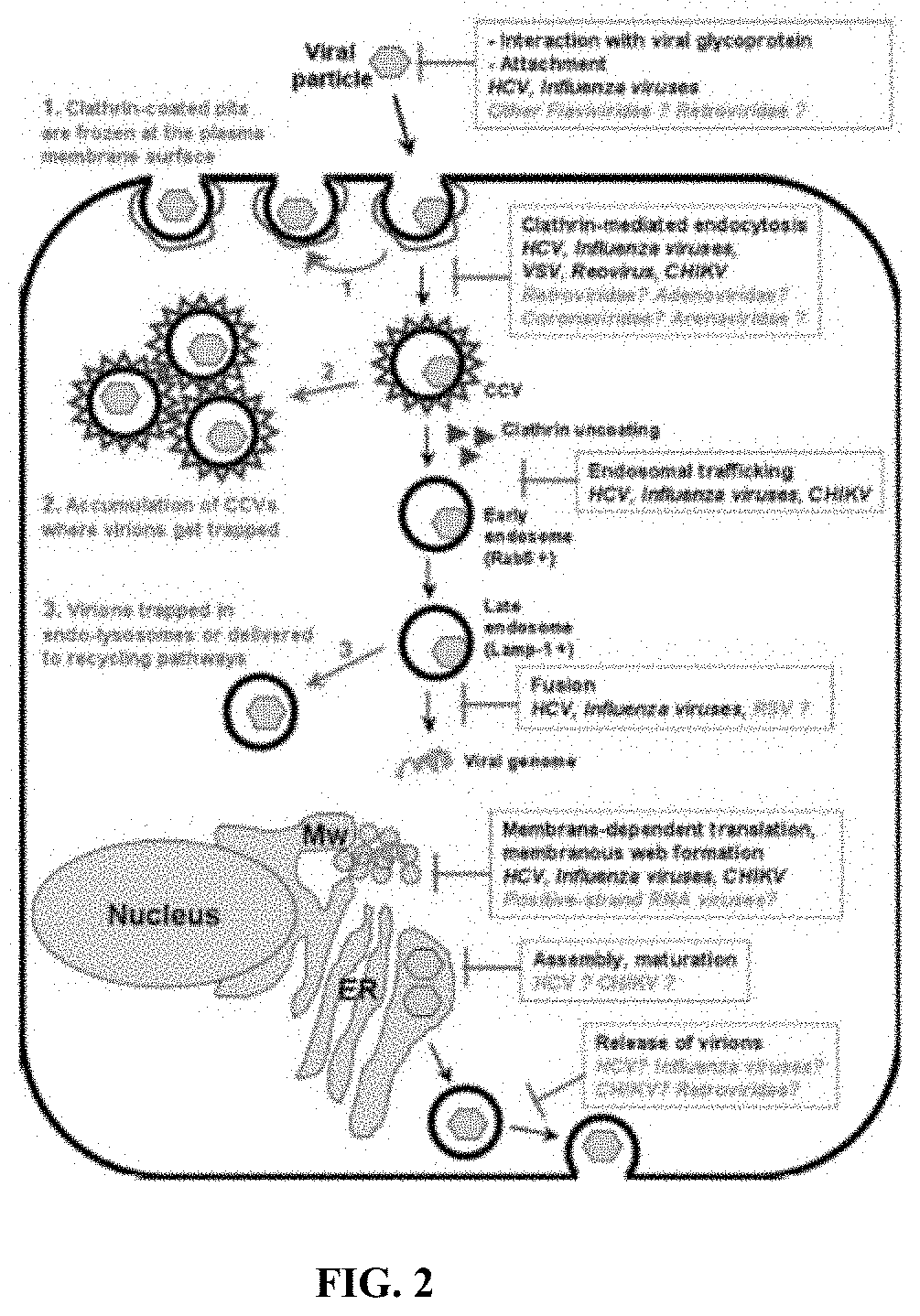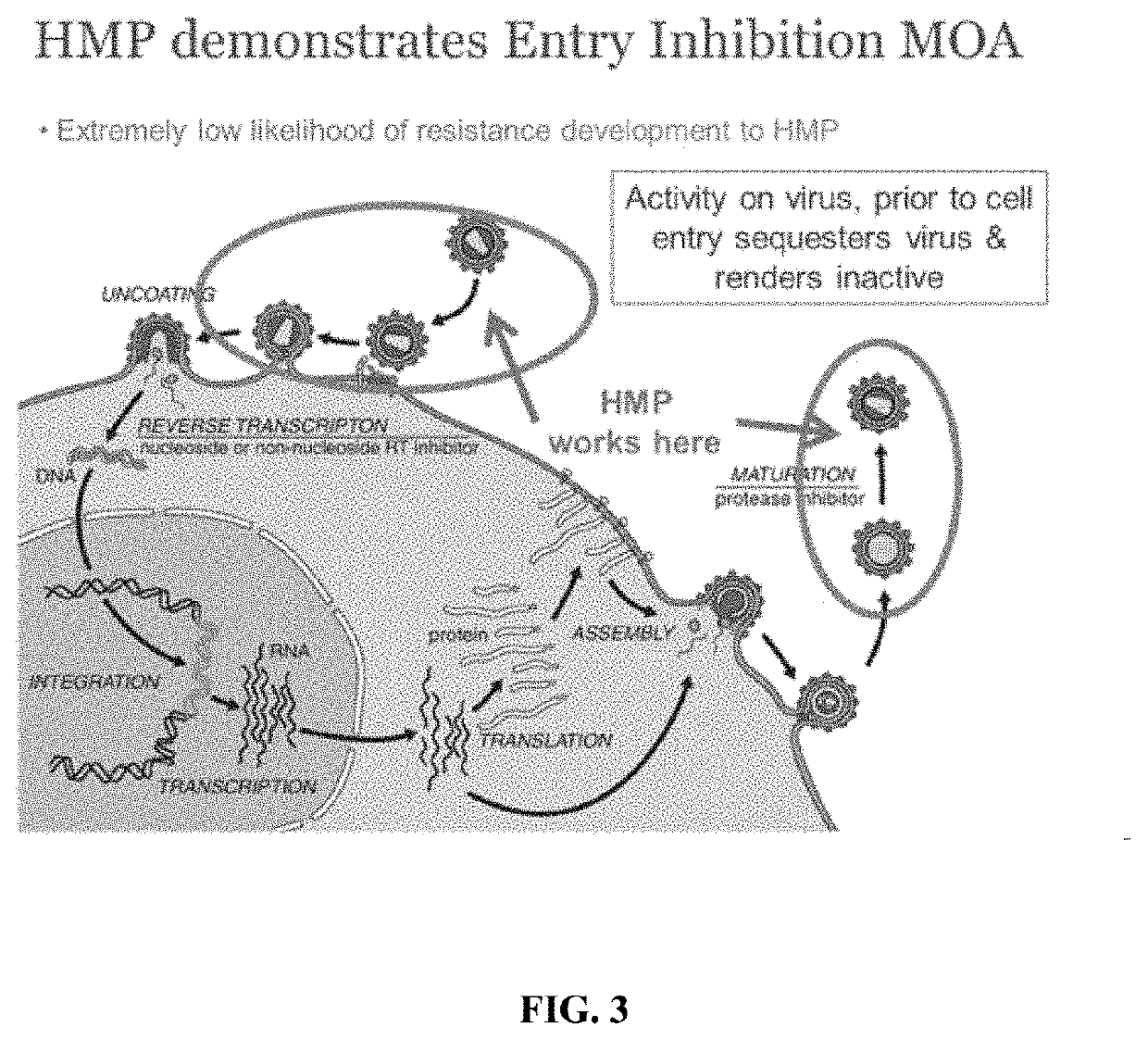Methods and compositions for inhibiting enveloped viruses using low molecular weight hydrophobically modified polymers
a technology of hydrophobic modification and composition, which is applied in the direction of organic active ingredients, pharmaceutical delivery mechanisms, synthetic polymeric active ingredients, etc., can solve the problems of increasing the likelihood of resistance and increasing the chances of inhibitory success, so as to reduce the likelihood of resistance and inhibit the transmission of viruses , the effect of increasing the chance of inhibitory success
- Summary
- Abstract
- Description
- Claims
- Application Information
AI Technical Summary
Benefits of technology
Problems solved by technology
Method used
Image
Examples
example 1
Inventive Examples E1-E3 and Comparative Examples C1-C3: Preparation of Compositions to be Tested
[0121]The compositions of E1-E3, A1 and C1-C3 were prepared according to the descriptions set forth below with materials in the amounts listed in Table 1. Compositions E1-E3 are in accordance with the compositions and methods of this invention. Composition A1 is in accordance with compositions and methods set forth in co-pending patent application Attorney Docket No.JC06079USNP filed concurrently herewith. Compositions C1-C3 are comparative compositions.
TABLE 1IngredientE1A1C1C2E2E3C3INCI namew / w %w / w %w / w %w / w %w / w %w / w %w / w %Potassium0.50—— 0.503.03.0—AcrylatesCopolymerPEG6000—0.5—————Cocamidopropyl——3.03.0———BetaineSodium laureth——3.03.0———SulfatePEG 80 Sorbitan——3.03.0———LaurateNonoxynol-9—————3.03.0SodiumqsqsqsqsqsqsqsHydroxideWaterqsqsqsqsqsqsqs*expressed in % w / w actives
Each of the compositions of Table 1 was independently prepared as follows:
[0122]E1—1.7 g of Potassium Acrylates ...
example 2
Inventive Examples E4E11l: Preparation of Illustrative Embodiments of the Compositions of This Invention
[0129]Stable anti-viral compositions of E4-E11 were prepared according to the materials and amounts listed in Table 2 and the methods set forth below.
TABLE 2E4E5E6E7E8E9E10E11INCI namew / w %w / w %w / w %w / w %w / w F %w / w %w / w %w / w %Carbomer0.750.75——0.75———Potassium Cetyl2.02.0——2.0———Phosphate (and)HydrogenatedPalm GlyceridesStearyl Alcohol0.3750.375———Polyglyceryl-100.375LauratePhenoxyethanol;2.52.5—0.62.5—0.6—EthylhexylglycerineMineral Oil8.08.0——8.0———Propylene Glycol—————39.94Potassium5105.00.50.05 0.05 0.05 0.05AcrylatesCopolymerHydroxyethyl-———0.2—1.60.2 -—celluloseCarbomer——15 ————15 Methylchloroiso-——0.2————0.2thiazolinone(and)MethylisothiazolinoneCoco-Glucoside——— 0.25————(and)GlyceryloleateLauryl Glucoside——— 0.25————(and)Polyglyceryl-2Dipoly-hydroxystearate(and) GlycerinGlycerin——— 0.18—— 0.18—Sodium Benzoate———0.5—0.20.5—Acrylates———0.5——0.5—CrosspolymerSodium Hydroxideqs...
example 3
[0139]Mildness Testing via Trans Epithelium Permeation (TEP) Test
[0140]Samples of E2, E3 and C3 were tested for TEP as per the method detailed set forth above.
TABLE 3SampleTEP: EC50E2>8E34.77 + / − 0.77C33.46 + / − 0.62
C3, which contains Nonoxynol N9 and water, demonstrated significant leakage compared to E2 and E3, both of which contained Potassium Acrylates Copolymer (E3 also containing Nonoxynol N9). Both E2 and E3 demonstrated superior mildness in TEP assay whereas C3 shows potential for membrane-damage that may result in penetration of agents via mucosal tissues.
PUM
| Property | Measurement | Unit |
|---|---|---|
| Mn | aaaaa | aaaaa |
| molecular weight | aaaaa | aaaaa |
| trans-epithelial permeability | aaaaa | aaaaa |
Abstract
Description
Claims
Application Information
 Login to View More
Login to View More - R&D
- Intellectual Property
- Life Sciences
- Materials
- Tech Scout
- Unparalleled Data Quality
- Higher Quality Content
- 60% Fewer Hallucinations
Browse by: Latest US Patents, China's latest patents, Technical Efficacy Thesaurus, Application Domain, Technology Topic, Popular Technical Reports.
© 2025 PatSnap. All rights reserved.Legal|Privacy policy|Modern Slavery Act Transparency Statement|Sitemap|About US| Contact US: help@patsnap.com



